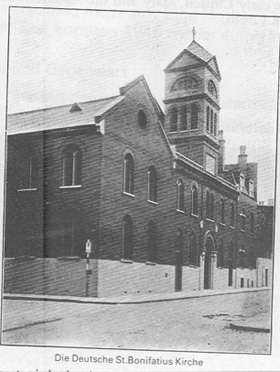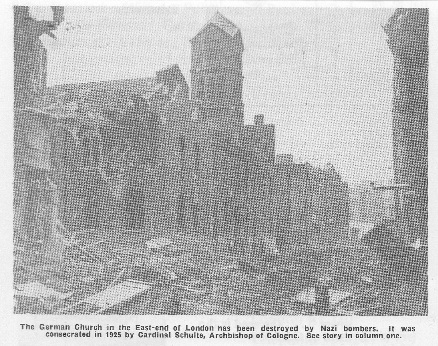The German Catholic mission in London
In London Before 1791 there could be found 'Penny Hotels'
To prevent them being suspect as 'Popish Mass Houses' a man at the entrance demanded an admission fee of one penny. To be a practising Roman Catholic in Henry VIII's England after the split with Rome in 1535 could spell danger, even to one's own life. It was not until 1791 that Parliament passed a law allowing Catholics to have their own churches. Before then the only permitted Catholic centres of worship were the chapels of embassies representing Catholic Countries. For German-speaking Catholics there was an opportunity to worship in the chapel of the Austrian and the Bavarian embassy. The Bavarian chapel in Warwick Street near Piccadilly Circus still exists, and has since become the Catholic Parish Church of 'Our Lady of the Assumption'.
The German Chapel and St. Boniface
The docklands area in London's East End has long attracted foreign workers. Around 1800 two German-speaking priests began to take care of German immigrants there: Fr. Johannes Becker, a Swiss, and Fr. Franz Muth, an Austrian. In 1809, they succeeded in establishing the 'German Chapel' in the house at 22 Great St. Thomas the Apostle Street near the present day Mansion House Underground Station in the City. They dedicated the chapel to SS Peter and Paul as well as to St. Boniface who is known for his close ties with Germany. Born in Devon he was christened in the name of Wynfrid. He became a priest of the Benedictine Order and took up missionary work in Germany by 716 converting the, by then, still heathen tribes of Friesland, Saxony, Thuringia and Hesse, to Christianity. With him came also women like Lioba and Walburga who became close co-workers in his mission. Pope Gregory II appointed him Bishop of Mainz and gave him the name of Boniface by which he has become known as the 'Apostle of the Germans'. It was therefore appropriate that the 'German Chapel' in his English homeland should be dedicated to him.
Church of St. Boniface in Whitechapel

The German Church has existed since 1809 and with it the German Catholic Mission. There was not, however, a closely-knit parish community as we understand it because of the continual movement of people arriving and departing. The East End of London had, until the outbreak of the First World War in 1914, contained a large influx of German-speaking immigrants. Others tended to move to areas of London where their work and trade was more profitable than in the traditionally poor East End. The small German Chapel in the City needed to expand in order to cope with the growing ministry. In 1862 the Methodist 'Zion Chapel' in Whitechapel, London El was acquired; a building with an oval-shaped interior that had once been used as a riding hall, a use which appears to have done the foundations no good. In April 1873, the domed roof collapsed. This unusual occurrence caused a sensation, and the generous help of many people contributed to building a new church completed at the end of 1875. Ten years later the church was extended and provided with a belfry fitted out with a chime of bells manufactured in the nearby Whitechapel Bell Foundry. The number of Germans in this area had increased to such an extent that the provision of a German primary school next to the church became necessary. Social and welfare activities were wanted, too, and lead to the organisation of certain associations: Gesellenverein, a craftsmen's association in the spirit of Fr. Kolping, a social reformer in Germany - and Kaufmannischer Verein, a merchants' association - both for adult education. The St.Vincent-de-Paul Society for men and the St. Elisabeth Society for women -both for welfare work among the poor - were also established.
'Pallottines' at St. Boniface's
The frequent changes of pastors gave rise to transfer the pastoral duties of the Mission to a religious order. So it came about that in 1903 priests of the Society of the Catholic Apostolate - called Pallottines - were entrusted with the task. This Society had been founded in Rome in 1835 by the priest Vincent Pallotti who, among many other interests, was concerned about the spiritual welfare of the many Italians who emigrated to England. In 1841, he sent two of his companions to London where they started the Italian community and church. It therefore seemed appropriate to entrust the German Mission to German priests of this Society, which had in the meantime grown in Germany. The Pallottine Fathers continue to carry out their commission at the German and Italian churches in London to this very day.
The World Wars and the German Mission

At the outbreak of the First World War in 1914, it seemed that the busy life at the Mission would come to a sudden end. Many Germans were either interned or deported. Nevertheless, thanks to the loyalty of people of German descent the Mission survived the war years. The church roof suffered slight damage during a Zeppelin air raid in 1917. The defect was soon repaired. When the war ended, the Mission recovered. According to the law of this country a church cannot he formally consecrated until all debts have been settled. St. Boniface's Church was still encumbered with mortgages. With the revival of the Mission, new efforts were made and, in 1925, the official consecration could take place —carried out by Cardinal Schulte, the Archbishop of Cologne - with great solemnity. Apart from some war deportees returning, there was little immigration from the Continent to Britain in the 1920's. Later arrivals from Germany were mainly Jews persecuted by the 'Third Reich'. Although a number of Germans had left the East End, St. Boniface’s Church in Whitechapel remained their spiritual home. The Second World War with its awful consequences did not spare the German Mission. In 1940, its premises were almost totally destroyed in repeated German air raids. Even so, hardly a Sunday passed by without the celebration of Mass, gathering the 'Old Germans' in the ruins. Their unfailing loyalty saved the Mission again during that war. They did not give up hope of rebuilding and made great sacrifices. A temporary chapel and an improvised community hall came into use in 1946.
Reconstruction to the Present Day

From 1949 onwards, a new influx of people from German-speaking countries arrived. A number of German prisoners of war had also remained in the country. The newcomers were mainly women and girls, many from refugee families in Germany. In those early post-war years, they were still unaware of the ‘economic miracle’ which was soon to revitalise the new Federal Republic of Germany. Many German-English marriages took place. In the following years, immigration has gradually changed to limited educational visits by young people. The German domestics and hospital orderlies turned into ‘au-pairs’ with contacts in family circles to learn and improve their English. In 1952, St. Lioba House in North West London was opened to provide a congenial meeting place for young Germans. This centre organises cultural events, guided tours and leisure time activities. The centre also keeps details of vacant ‘au-pair’ jobs and vets them to ensure a satisfactory and happy stay for these young people with English families. After long and careful architectural and financial planning, the foundation stone of the new St. Boniface’s Church was laid by Cardinal Godfrey, the Archbishop of Westminster, on the 7th November 1959. On the first Sunday of October 1960, the rebuilding was completed and solemnly opened by the same Cardinal assisted by Bishop Cleven, Auxiliary Bishop of Cologne. Throughout the planning, it was taken into consideration that London, the capital of Great Britain, would always draw people from abroad for various reasons: tourism, business, study. Therefore, a centre was planned with hostel facilities. In 1970, it was achieved and named Wynfrid House, having again St. Boniface in mind with his Christian name Wynfrid. The need of a centre of this kind has since been fully justified. It is a much-frequented guesthouse and meeting place. Although it stands in a part of London that has ceased to attract immigrants from Germany, its close proximity to the City of London gives it the advantage of easy access to the main tourist, business and shopping areas of London. One of the results of Britain's entry into the Common Market was the sharp increase in the number of professional people coming to London. Because of their usually limited stay families from German-speaking countries worry about the continuation of their children's education in German. The call for a German School was realized in 1972. It offers a total school education from pre-schooling up to `Abitur', i.e. 'A' levels. Because the school lies in suburban Petersham/Richmond, German families seek accommodation in that area. Thus for a considerable number of people the German Mission is caring for, an outpost of the Mission has been established in the Catholic Church of St. Thomas Aquinas in Ham. Twice a month a Sunday service is held there. The German Mission participates in the school's religious education and prepares the children for the sacraments. The Catholic Church does not leave its believers alone in foreign countries. For children, especially, even a break of short duration abroad can harm their contact with Church and Faith in their mother tongue. Sooner or later most of them will return to German-speaking homeland.